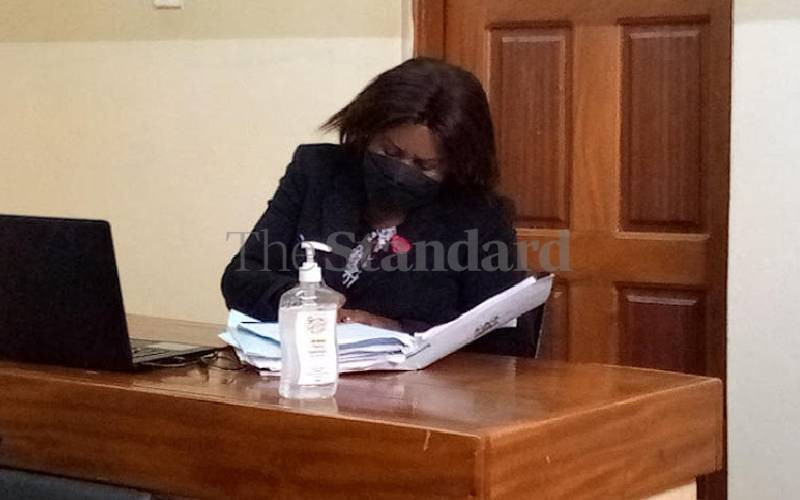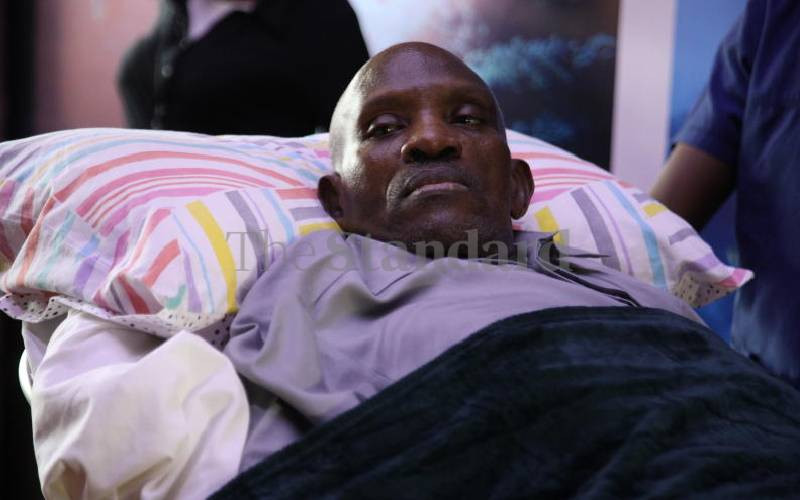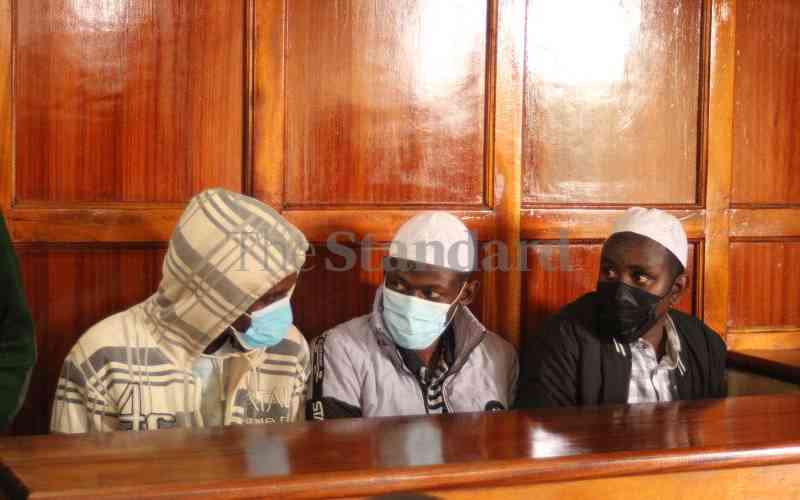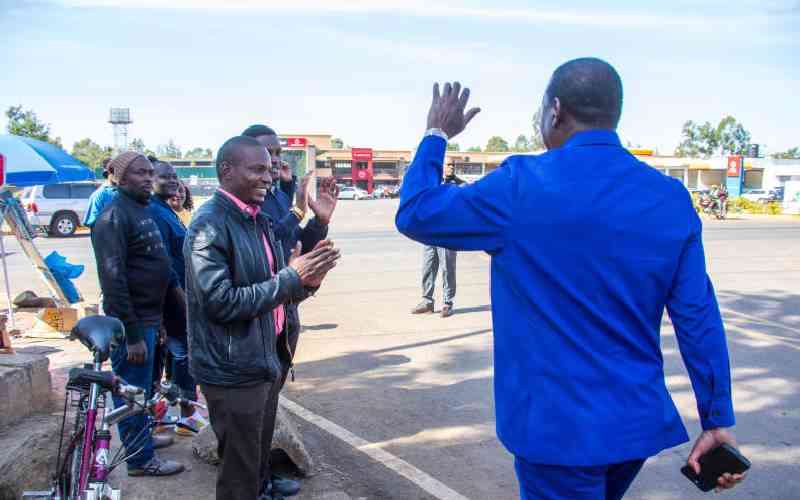 |
|
Mr Edward Yesse Mule shows a keffiye that has now become a souvenir. He used it for various purposes during his incarceration. [PICTURES: EVANS HABIL] |
In January 2012, Al Shabaab overran an AP Post in Gerille, Wajir, and captured Burderi DO Edward Yesse Mule and Immigration official Fredrick Irungu Wainaina. Both were released a week ago. Mr Mule shares his recollection of how they survived attack that killed eight, their journey and harrowing experience in Somalia and eventual release as told to KIPCHUMBA SOME ([email protected])
“The scene before our world came tumbling down,” recalls Edward Yesse Mule, the Kenyan District Officer abducted in 2012 in Wajir County by Somalia’s militant group Al Shabaab.
“It is 4 O’clock and sunset is approaching. We are seated with Wainaina (Fredrick Wainaina, an Immigration Officer) near the dispensary taking the evening tea. Across, I can see my Somali clerks, around four of them.
“A little bit further ahead, I can see people milling in an open space talking in low tones. Nearer to me a man is skinning a goat, our dinner for the night.
“Behind us, a woman is frying some food in a sufuria. Another one is going to fetch water with a jerrican. Then suddenly, almost instantly, as I am talking to Wainana, everything goes quiet.
“I scan where the clerks were seated…they are not there. The open space where people were milling a few minutes ago is empty. Where has everyone gone?
Surprise attack
“I can see the local National Intelligence Services (NIS) officer walking, playing with a can of pineapples we had sent for the same day. He is heading towards the village.
“I try to figure out what is happening. Why were people disappearing? Where were they going?
“Then I turn and look at the guy who was skinning the goat, and I realise the skin he is holding aloft is full of holes…tattered. The first volley of bullets had fallen.
It was Wednesday, January 11, 2012. The Al Shabaab militants had struck the Gerille AP Camp in Wajir County on the Kenya-Somalia border, ostensibly in retaliation to the Kenya Defence Forces’ offensive against them in October 2011.
The surprise attack was the worst by the militants since KDF’s Operation Linda Nchi began.
It left eight people dead, among them three AP officers and three police reservists.
The Islamist group also captured two government officials — Burderi DO Edward Yesse Mule and Fredrick Irungu Wainaina, the local Immigration Officer.
Stay informed. Subscribe to our newsletter
The officials were conducting a vetting exercise for issuance of Identity Cards in Gerille, and it was their third and last day.
The previous day on Tuesday, they had received intelligence indicating that Al Shabaab was planning to attack the area.
But they were later informed that the assailants would not attack because the officers were giving out IDs to fellow Somalis.
That gave the government officials some hope and a sense of safety, but Mule still sent a signal to Wajir asking for reinforcement, which had not arrived by the time of the attack.
On the fateful Wednesday, it was a normal day. Mule woke up, took a bath and ate a simple breakfast before embarking on the vetting exercise at 10am.
Despite reassurances that all was well, rumours of an imminent attack swirled.
“The rumours reached me around lunch time. I then summoned the area Chief and asked him about the credibility of the rumours. He told me those were lies. He assured me there would be no attack.
“The NIS officer told me that the militants had been sighted across the border but he was not sure whether they were going to strike. Nonetheless, we resumed the exercise hoping that we would be done by 3 O’clock,” said Mule.
Decision to leave
The DO decided that he and his team were not going to spend the night in Gerille. Despite more people streaming in for the vetting, he closed the exercise at around 4 O’clock. But then, getting out became impossible.
His team was big, and they had only one car. Mule realised that it would be impossible for all of them to get out of Gerrille for Wajir town, a distance of over 100 kilometres, that evening.
Mule informed his team that they were going to spend the night at Gerille until the next morning when they would get an additional car.
Little did he know how fatal that decision would turn out to be.
Mule would smoke behind one of the houses where his staff slept but on this day, an unusual sight greeted him.
The NIS officer and the police inspector were talking in low tones in some nearby bushes.
They were not within earshot, so he assumed they were consulting on security matters. They did not give him a brief. He proceeded to the nearby dispensary for tea.
It was here that the local chief had hired a team to cook for the officials, and it was moments after they settled for the afternoon tea after 4pm that the peace was shattered by the sound of gunfire.
“At first we did not know what was happening. Wainaina, the woman frying stuff and the guy skinning the goat and I just sat there and looked at each other in amazement.
“Soon, the second volley started. The woman frying food took off at full speed towards the village. We realised that we are under attack and we started following her at full speed.
“She disappeared into the village. But just immediately ahead of me, there were numerous pockmarks in the soft sand. A huge cloud of dust was forming.
 The Standard Group Plc is a
multi-media organization with investments in media platforms spanning newspaper
print operations, television, radio broadcasting, digital and online services. The
Standard Group is recognized as a leading multi-media house in Kenya with a key
influence in matters of national and international interest.
The Standard Group Plc is a
multi-media organization with investments in media platforms spanning newspaper
print operations, television, radio broadcasting, digital and online services. The
Standard Group is recognized as a leading multi-media house in Kenya with a key
influence in matters of national and international interest.
 The Standard Group Plc is a
multi-media organization with investments in media platforms spanning newspaper
print operations, television, radio broadcasting, digital and online services. The
Standard Group is recognized as a leading multi-media house in Kenya with a key
influence in matters of national and international interest.
The Standard Group Plc is a
multi-media organization with investments in media platforms spanning newspaper
print operations, television, radio broadcasting, digital and online services. The
Standard Group is recognized as a leading multi-media house in Kenya with a key
influence in matters of national and international interest.










